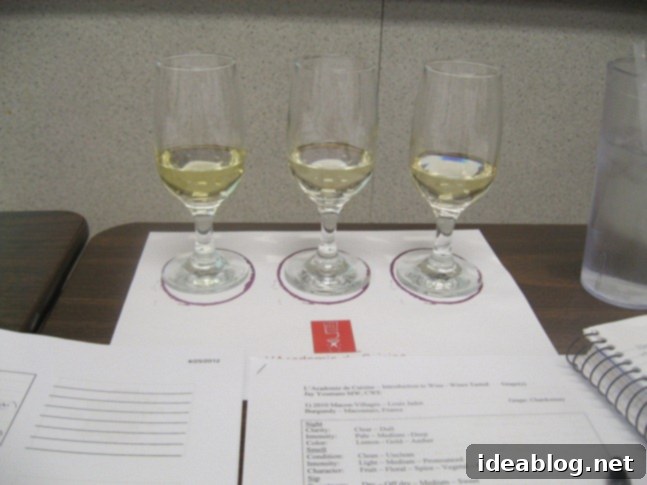Culinary School Chronicles: Mastering Techniques, Exploring Flavors, and Uncorking Wine Knowledge
Welcome back to another exciting installment from my culinary school journey! Yesterday’s curriculum was a captivating blend of intriguing challenges, delightful discoveries, and a much-anticipated foray into the world of wine. As aspiring chefs, every day presents a new opportunity to refine our skills, broaden our palates, and tackle dishes that push our boundaries—some proving more palatable than others, but always rich in learning experiences.
Wednesday’s Culinary Exploration: A Three-Course Learning Experience
Wednesday’s menu was designed to challenge us with diverse ingredients and complex techniques, moving from the delicate subtleties of seafood to the comforting richness of a classic French dessert. Each dish offered unique insights into presentation, flavor balance, and traditional culinary artistry.
Course 1: Oysters with Champagne Glacee and Sautéed Beets
Our first course introduced us to a true test of precision and nerve: oysters served with a delicate champagne glacee. This marked our initial encounter with oysters in a professional setting, and for most of us, it was our very first time shucking them. The process was surprisingly challenging, especially given the unusually shaped oysters I encountered. It quickly became clear that this delicate task requires a steady hand and a keen understanding of the mollusk’s anatomy. Chef Patrice guided us through a relatively safer shucking method, emphasizing technique over brute force, yet the “horror stories” I’d heard still made it a slightly nerve-wracking experience. I sincerely hope this isn’t a regular feature at my future restaurant!
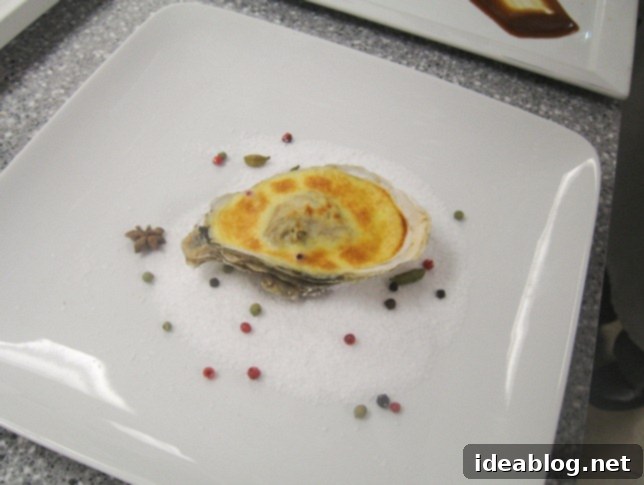
The preparation of the oyster dish was quite intricate. After carefully shucking the oysters, we reserved their natural brine—essentially seawater—and reduced it with champagne to create a concentrated, flavorful base. The oysters themselves were briefly blanched to tenderize them. Next, we meticulously cleaned the oyster shells before filling them with finely julienned beets, lightly sautéed to bring out their earthy sweetness. The blanched oysters were then placed on top of the beets. The crowning glory was a sabayon, into which the reduced oyster and champagne juice had been folded, creating a rich, airy, and intensely flavorful topping. Finally, these creations were gratineed in the salamander until golden brown, achieving a beautiful caramelized finish. While the technique was impressive, the overall flavor profile was not personally to my taste. I’m still coming to terms with oysters, and this particular rendition presented a rather unique combination of textures and flavors that felt a bit unusual to me.
For a visually appealing presentation, each oyster was nestled on a bed of kosher salt, adorned with an assortment of colored peppercorns and star anise. The star anise, with its distinct shape, cleverly resembled tiny starfish, transforming the plate into a charming miniature beach scene. It was a thoughtful and creative touch that added a playful element to a sophisticated dish.
Course 2: Braised Pork Belly Terrine with Black and White Bean Purees
Our second course, while conceptually quite distinct, offered a much more satisfying taste experience. The journey for this dish began the day before, with a lengthy braise of pork belly for several hours. This slow cooking method ensured incredible tenderness and allowed us to extract a rich, flavorful jus. After braising, we carefully removed the fat and shredded the succulent pork meat. This shredded pork was then mixed with a vibrant array of ingredients: capers, cornichons, Dijon mustard, fresh tarragon, green onions, and finely diced shallots. The acidity from the capers, cornichons, and mustard provided a beautiful counterbalance to the richness of the pork, elevating the flavor profile significantly.
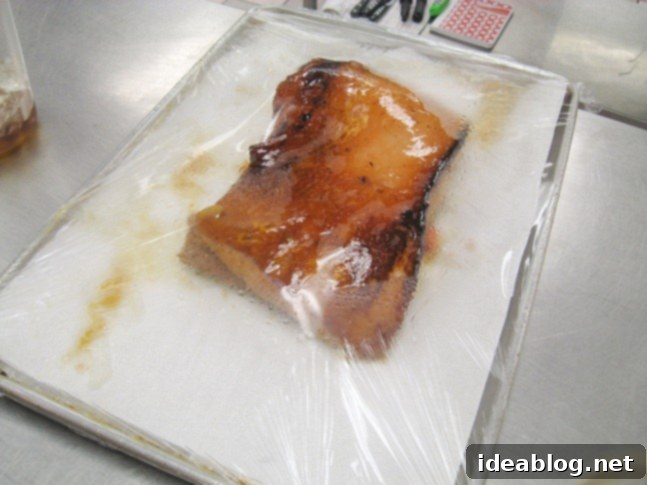
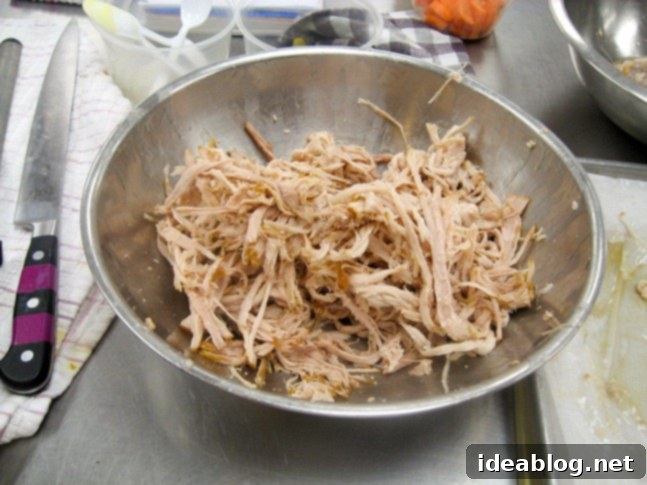
The truly unique part of this dish came in its transformation into a terrine. The flavorful pork mixture was tightly packed into a terrine mold and chilled overnight, allowing it to set and form a cohesive “meatloaf-like” structure. For service, we sliced the firm terrine into neat rectangles, which were then breaded and fried to achieve a beautifully crisp exterior while retaining a tender, flavorful interior. This textural contrast was absolutely delightful. We served this alongside two velvety smooth purees—one made from rich black beans and another from creamy white navy beans, expertly prepared for us by Chef Michel. A reduced pork jus, intensifying the braising liquid’s natural flavors, completed the plate. While our dishes are typically known for their visual appeal, this particular presentation was admittedly one of the less aesthetically striking. The overall palette was quite “beige,” but appearances can be deceiving; it truly tasted far better than it looked, showcasing how deeply flavor can compensate for a subdued visual.
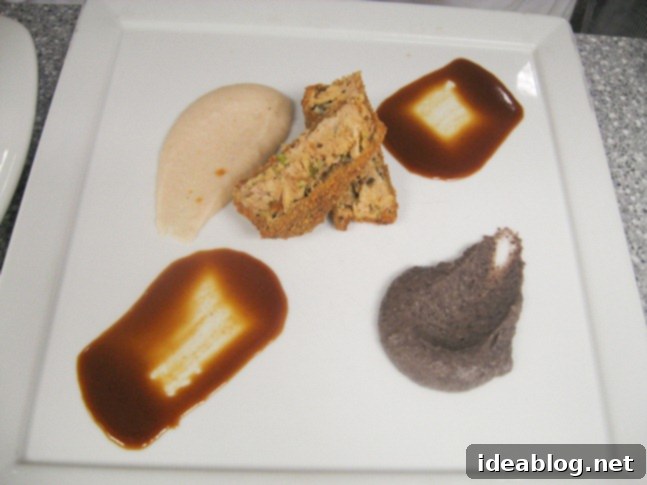
Course 3: The Timeless Delight of Charlotte Aux Pommes
Finally, dessert arrived, and it was a resounding success! We crafted a classic French dish known as “Charlotte Aux Pommes.” This is a rustic yet elegant dessert, historically conceived as a clever way to utilize old bread and apples. Our modern interpretation elevated this humble origin. While the traditional recipe often calls for raw apples, we enhanced the flavor profile by sautéing green apples with generous amounts of clarified butter and a touch of sugar to encourage caramelization. The pan was then deglazed with Applejack, adding a nuanced depth of flavor, before a dash of cinnamon infused the apples with a comforting warmth and subtle spice.
The assembly of the Charlotte was an exercise in meticulous layering. We lined individual ramekins with very thinly sliced bread, each piece carefully soaked in clarified butter and then dipped in sugar on one side. This ensured that during baking, the bread would caramelize to a beautiful dark, crusty finish. Between layers of our fragrant apple filling, we added a tiny spoonful of sweet jam and a sprinkle of toasted walnuts, introducing delightful bursts of flavor and texture. The ramekins were then covered with foil and baked in the oven until the apples were tender and the bread casing achieved that perfect golden-brown hue.
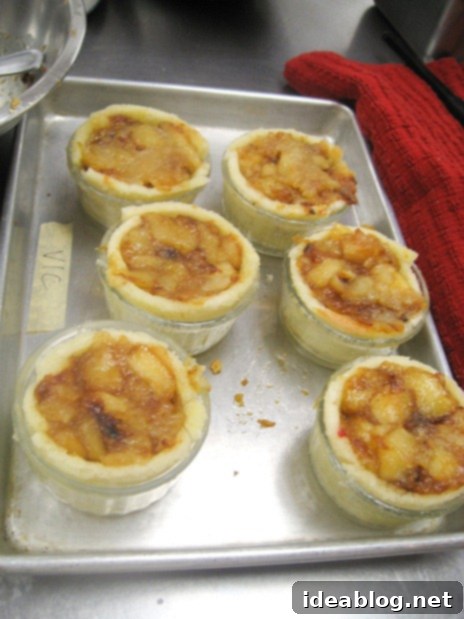
Upon unmolding, the Charlottes revealed their gorgeous form—super buttery, intensely aromatic, and utterly delicious. We served this exquisite dessert alongside a classic crème anglaise and a vibrant blueberry coulis, utilizing whatever seasonal fruit coulis we had readily available in the fridge. The rich, apple-cinnamon flavors complemented the creamy anglaise and tangy coulis perfectly. I can imagine this would also be an absolute dream paired with a scoop of vanilla bean ice cream!
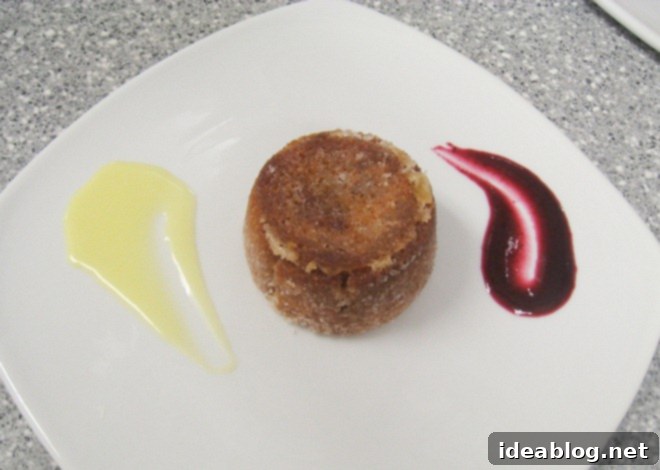
An Evening of Enlightenment: Our First Wine Class
The afternoon brought what many of us considered the highlight of our week: our inaugural wine class. This wasn’t just any wine class; it was taught by a certified Master of Wine—a title of extraordinary prestige and rarity. To put it into perspective, there are reportedly only 28 Masters of Wine in the entire United States, with a mere single individual holding this coveted certification in the Washington, D.C. area. Achieving this designation is an incredibly rigorous and demanding journey, making our instructor’s expertise truly unparalleled.
The class delved deep into the fascinating world of viticulture and oenology. We explored the characteristics of various red and white grape varietals, familiarizing ourselves with some of the major types that define the global wine landscape. The theoretical knowledge was immediately put into practice through an engaging tasting session. We had the privilege of sampling three distinct white wines—a crisp Sauvignon Blanc, a buttery Chardonnay, and an aromatic Riesling—as well as three classic reds—a delicate Pinot Noir, a robust Cabernet Sauvignon, and a spicy Syrah. Our instructor expertly guided us through the sensory analysis of each wine, teaching us how to meticulously assess its clarity, aroma profile, body, taste, and finish. It was an incredibly informative session, covering aspects I’ve been eager to learn about for a long time. This hands-on experience and the depth of knowledge shared left us all in a wonderfully elevated mood, eager for the next two classes.
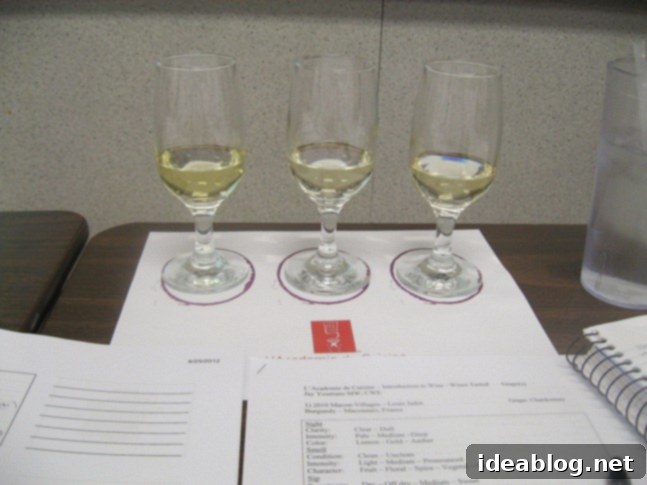
Overall, Wednesday was a remarkably good day, filled with both culinary challenges and enriching educational experiences. The balance of hands-on cooking and theoretical learning, especially in a subject as captivating as wine, made for a truly memorable day in culinary school. Here’s hoping today’s service proves equally successful, though that’s a story for another time!
Looking ahead, tomorrow promises another exciting Market Basket challenge, where creativity and adaptability are key. Additionally, I have another full-day stage scheduled for this Saturday, which I anticipate will be a valuable and interesting opportunity to gain more practical kitchen experience. The journey continues to be filled with dynamic learning and new adventures!
